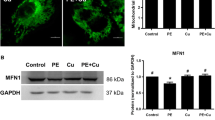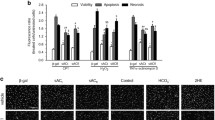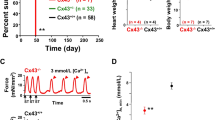Abstract
Mitochondrial contact sites (MiCS) are dynamic structures involved in high capacity transport of energy from mitochondria into the cytosole. Previous studies revealed that in normal conditions the actual number of MiCS is in correlation with the energy requirements of the heart, particularly with those for its contractile work. Although the detailed mechanisms of signalling between the processes of energy utilisation and MiCS formation in the heart are not yet elucidated, it is known that intracellular Ca2+ transients are intimately involved in this crosstalk. The present study is devoted to investigation of Ca2+-linked MiCS formation in healthy adult hearts and in hearts with modified Ca2+-handling such as in developing, in juvenile and diabetic myocardium. Experiments were performed on hearts of healthy rats on the 22nd embryonal day, 1st, 4th, 7th and 14th postnatal days as well as on adult hearts. Diabetic hearts were investigated on the 8th day after streptozotocin injection (45 mg.kg–1 i.v.) to adult rats. Intracellular Ca2+ movements were affected by modulation of Ca2+ concentration in perfusion solution (1.6 or 2.2 mmol.l–1) in isolated, Langendorff-perfused hearts, by calcium paradox (CaP) or by replacing of Ca2+ by Cd2+ ions. Elevation of extracellular Ca2+ was reflected by 30.1, 10.4 and 24.1% increase in intracellular free Ca2+ concentration in healthy adult, diabetic and 14-day old hearts respectively. In developing hearts the amount of MiCS was culminating on the 4th postnatal day. In adult hearts, elevated calcium in the perfusion solution, CaP as well as diabetes led to a significant increase in the amounts of MiCS formed (58.1, 77.2 and 86.5% respectively; p < 0.05). Diabetic and 14-day old hearts naturally exhibited amounts of MiCS comparable to those obtained by Ca2+-stimulation of MiCS formation in adult healthy hearts. In contrast to healthy controls, perfusion of diabetic and 14-day old hearts with elevated Ca2+ as well as induction of CaP exerted little influence on MiCS formation (4.4 and 8.2% for elevated Ca2+; 2.9 and 10.7% for CaP; p > 0.05). A replacement of Ca2+ by Cd2+ ions lowered the amount of MiCS in healthy adult and diabetic hearts (61 and 52.2%; p < 0.05). In conclusion, during development, the formation of MiCS may be influenced by both, permanent stimulation by Ca2+-signalling and the availability of mCPK. In healthy adult hearts the amount of MiCS is modulated by intracellular Ca2+ transients in response to changes in extracellular Ca2+ concentration. In diabetic hearts the modulation of MiCS formation is naturally attenuated, apparently as a consequence of persisting alterations in Ca2+-handling.
Similar content being viewed by others
References
Soboll S, Brdiczka D, Jahnke D, Schmidt A, Schlattner U, Wendt S, Wyss M, Wallimann T: Octamer-dimer transitions of mitochondrial creatine kinase in heart disease. J Mol Cell Cardiol 31: 857–866, 1999
Knoll G, Brdiczka D: Changes in freeze-fractured mitochondrialmembranes correlated to their energetic state - dynamic interactions of the boundary membranes. Biochim Biophys Acta 773: 102–110, 1993
Biermans W, Bernaert I, De Bie M, Nijs B, Jacob W: Ultrastructural localisation of creatine kinase activity in the contact sites between inner and outer mitochondrial membranes in rat myocardium. Biochim Biophys Acta 974: 74–80, 1989
Wyss M, Smeiting J, Wevers RA, Wallimann T: Mitochondrial creatine kinase: A key enzyme of aerobic energy metabolism. Biochim Biophys Acta 1102: 119–166, 1992
Duchen MR: Mitochondria and calcium: From cell signalling to cell death. J Physiol 529: 57–68, 2000
Territo PR, French SA, Balaban RS: Simulation of cardiac work transitions, in vitro: Effects of simultaneous Ca2+ and ATPase additions on isolated porcine heart mitochondria. Cell Calc 30: 19–27, 2001
Bakker A, Monosikova R, Sima F, Ziegelhöffer A, Jacob W: Effect of different calcium concentrations on mitochondria: An ultrastructural morphometric study. In: Proceedings of the 10th European Symposium on Electron Microscopy. Electron Microscopy 31: 90–100, 1992
Bakker A, Bernaert I, De Bie M, Ravingerová T, Ziegelhöffer A, Van Belle H, Jacob W: The effect of calcium on mitochondrial contact sites: A study on isolated rat hearts. Biochim Biophys Acta 1224: 583–588, 1994
Allso SN, Lincoln TM, Wilson GL, Green SJ, Watanabe AM, Schaffer S: Non-insulin-dependent diabetes-induced defects in cardiac cellular calcium regulation. Am J Physiol 260: C1165–C1171, 1991
Pierce GN, Russell JC: Regulation of intracellular Ca2+ in the heart during diabetes. Cardiovasc Res 34: 41–47, 1997
Pierce GN, Ramjiwan B, Meng H-P: Cardiac sarcolemma membrane alterations during the diabetic cardiomyopathy. In: M. Nagano, N.S. Dhalla (eds), The Diabetic Heart. Raven Press, New York, 1991, pp 229–236
Dhalla NS, Wang X, Beamish RE: Intracellular calcium handling in healthy and failing hearts. Exp Clin Cardiol 1: 7–20, 1996
Dhalla NS, Liu X, Panagia V, Takeda N: Subcellular remodeling and heart dysfunction in chronic diabetes. Cardiovasc Res 40: 239–247, 1998
Huang YS, Horrobin DF, Manku MS, Mitchell J, Ryan MA: Tissue phospholipid fatty acid composition in the diabetic rat. Lipids 19: 367–370, 1984
Ziegelhoffer A, Ravingerová T, Styk J, Šeboková J, Waczulíková I, Breier A, Džurba A, Volkovová K, Čársky J, Turecký L: Mechanisms that may be involved in calcium tolerance of the diabetic heart. Mol Cell Biochem 176: 191–198, 1997
Mahony L: Regulation of intracellular calcium concentration in the developing heart. Cardiovasc Res 31: E61–E67, 1996
Vornanen M: Excitation-contraction coupling of the developing rat heart. Mol Cell Biochem 163: 5–11, 1996
Glatz JFC, Veerkamp JH: Postnatal development of palmitate oxidation and mitochondrial enzyme activities in rat cardiac and skeletal muscle. Biochim Biophys Acta 711: 327–335, 1982
Hansford RG: Role of calcium in respiratory control. Med Sci Sports Exerc 26: 41–51, 1994
Tinder P: Determination of blood glucose using 4–amino phenazon as oxygen acceptor. J Clin Pathol 22: 246–253, 1969
Watson D: A simple method for determination of serum cholesterol. Clin Chim Acta 5: 613–615, 1960
Fossati P, Prencipe L: Serum triglycerides determined colorimetrically with an enzyme that produces hydrogen peroxide. Clin Chim Acta 28: 2077–2080, 1982
Biermans W, Bernaert I, De Bie M, Nijs B, Jacobs W: Ultrastructural localisation of creatine kinase activity in the contact sites between inner and outer mitochondrial membranes in rat myocardium. Biochim Biophys Acta 974: 74–80, 1989
Baddeley AJ, Gundersen HJG, Cruz-Orive LM: Estimation of surface area from vertical sections. J Microsc (Oxford) 142: 259–276, 1986
Bessman SP, Yang WCT, Geiger PJ, Erickson-Viitanen S: Intimate coupling of creatine phosphokinase and myofibrillar adenosinetriphosphatase. Biochem Biophys Res Commun 96: 1414–1420, 1980
Bessman SP, Geiger PJ: Transport of energy in muscle: The phosphocreatine shuttle. Science 211: 448–452, 1981
Brdiczka D: Contact sites between mitochondrial envelope membranes - structure and function in energy-transfer and protein-transfer. Biochim Biophys Acta 1071: 291–312, 1991
Poizat C, Grably S, Cuchet P, Keriel C: Relationship between heart function and energy metabolism: A study on isolated rat heart. Arch Physiol Biochem 104: 71–80, 1996
McCormack J, Halestrap AP, Denton RM: Role of calcium ions in regulation of mammalian intramitochondrial metabolism. Physiol Rev 70: 391–425, 1990
Ohata H, Chacon E, Tesfai SA, Harper IS, Herman B, Lemasters JJ: Mitochondrial Ca2+ transients in cardiac myocytes during the excitation contraction cycle: Effects of pacing and hormonal stimulation. J Bioenerg Biomembr 30: 207–222, 1998
Sentex E, Laurent A, Martine L, Gregoire S, Rochette L, Demaison L: Calcium-and ADP-magnesium-induced respiratory uncoupling in isolated cardiac mitochondria: Influence of cyclosporin A. Mol Cell Biochem 202: 73–84, 1999
David G: Mitochondrial clearance of cytosolic Ca2+ in stimulated lizard motor nerve terminals proceeds without progressive elevation of mitochondrial matrix [Ca2+]. J Neurosci 19: 7495–7506, 1999
Ziegelhöffer-Mihalovičová B, Okruhlicová Ł, Tribulová N, Ravingerová T, Volkovová K, Šeboková J, Ziegelhöffer A: Mitochondrial contact sites detected by creatine phosphokinase activity in the hearts of healthy and diabetic rats: Is the contact sites formation a calciumdependent process? Gen Physiol Biophys 16: 329–338, 1997
Ziegelhoffer A, Ravingerová T, Styk J, Džurba A, Volkovová K, Čársky J, Waczulíková I: Hearts with diabetic cardiomyopathy: Adaptation to calcium overload. Exp Clin Cardiol 3: 158–161, 1998
Ishikawa T, Kajiwara H, Kurihara S: Alteration in contractile properties and Ca2+ handling in streptozotocin-induced diabetic rat myocardium. Am J Physiol. 277: H2185–2194, 1999
Ren J, Bode AM: Altered cardiac excitation-contraction coupling in ventricular myocytes from spontaneously diabetic BB rats. Am J Physiol 274: H238–244, 2000
Ziegelhoffer A, Ravingerová T, Styk J, Volkovová K, Šeboková J, Breier A: Diabetic cardiomyopathy in rats: Biochemical mechanisms of increased tolerance to calcium overload. Diabetes Res Clin Pract 31 (suppl): S93–S103, 1996
Wolf WJ, Rex KA, Geshi E, Sordahl LA: Postnatal changes in heart 44 mitochondrial calcium and energy. Am J Physiol 261: H1–H8, 1991
Fisher DJ: Recent insights into the regulation of cardiac Ca2+ flux during perinatal development and in the cardiac failure. Curr Opin Cardiol 10: 44–51, 1995
Bassani RA, Fagian MM, Bassani JW, Vercesi AE: Changes in calcium uptake rate by rat cardiac mitochondria during postnatal development. J Mol Cell Cardiol 30: 2013–2023, 1998
Tribulová N, Okruhlicová Ł, Ziegelhöffer-Mihalovičová B, Slezák J: Myocardial ischemic tolerance: Differences between immature and adult rats. In: B. Ošţádal, M. Nagano, N. Takeda, N.S. Dhalla (eds), The Developing Heart. Lippincott-Raven, PA, 1997, pp 407–425
Andres A, Satrustegui J, Machado A: Development of enzymes of energy metabolism in rat heart. Biol Neonate 45: 78–85, 1984
Kernec F, Nadal L, Rocher Ch, Mateo P, de Certaines J, La Rumeur E: Mitochondrial creatine kinase functional development in post-natal rat skeletal muscle. A combined polarographic/31P NMR study. Mol Cell Biochem 194: 165–1710, 1999
Dowell RT, Fu MC: Heterogenous cellular expression of creatine kinase isoenzyme during normal rat heart development. Mol Cell Biochem 178: 87–94, 1998
Hoerter JA, Ventura-Clapier R, Kuznetsov AV: V-1 compartmentation of creatine kinases during perinatal heart development of mammalian heart. Mol Cell Biochem 133/134, 277–286, 1994
Dowell RT: Mitochondrial component of the phosphorylcreatine shuttle is enhanced during rat heart perinatal development. Biochem Biophys Res Commun 141: 319–325, 1986
Grossman SH, Sellers DS: Subunit conformation and dynamics in a heterodimeric protein: Studies of the hybrid isozyme of creatine kinase. Biochim Biophys Acta 1387: 447–453, 1998
Sulakhe PV, Dhalla NS: Excitation-contraction in heart. IV. Energy dependent calcium transport in the myocardium in developing rat. Life Sci 9: 1363–1370, 1970
Hallman M, Kankare P: Mitochondrial and microsomal phospholipid phosphorus metabolism during postnatal growth in rat heart and liver. Lipids 14: 435–440, 1979
Zeleznikar RJ, Heyman RH, Graeff RM, Walseth TF, Dawis SM, Butz EA, Goldberg ND: Evidence for compartmentalized adenylate kinase catalysis serving a high energy phosphoryl transfer function in rat skeletal muscle. J Biol Chem 265: 300–311, 1990
Zeleznikar RJ, Džeja PP, Goldberg ND: Adenylate kinase-catalysed phosphoryl transfer couples ATP utilisation with its generation by glycolysis in intact muscle. J Biol Chem 270: 7311–7319, 1995
Tanabe T, Yamada M, Noma T, Kajii T, Nakazawa A: Tissue specific and developmentally regulated expression of the genes encoding adenylate kinase isozymes. J Biochem 113: 200–207, 1993
Gollnick PD: Metabolic regulation in skeletal muscle: Influence of endurance training as exerted by mitochondrial protein concentration. Acta Physiol Scand Suppl 556: 153–166, 1986
Bass A, Stejskalová M, Ošţádal B, Procházka J: Postnatal development of energy supplying metabolism in the rat myocardium. Physiol Bohemoslov 38: 531, 1989
Murashita T, Borgers M, Hearse DJ: Developmental changes in tolerance to ischaemia in the rabbit heart: Disparity between interpretation of structural enzymatic and functional indices of injury. J Mol Cell Cardiol 24: 1143–1154, 1992
Džeja PP, Kałvenas A, Toleikis A, Praškevičius A: The effect of adenylate kinase activity on the rate and efficiency of energy transport from mitochondria to hexokinase. Biochem Int 10: 259–265, 1985
Wallimann T, Wyss M, Brdiczka D, Nicolay K, Eppenberger HM: Intracellular compartmentation, structure and function of creatine kinase isoenzymes in tissues with high and fluctuating energy demands: The ‘phosphocreatine circuit’ for cellular energy homeostasis. Biochem J 281:21–40, 1992
Author information
Authors and Affiliations
Rights and permissions
About this article
Cite this article
Ziegelhöffer-Mihalovičová, B., Ziegelhöffer, A., Ravingerová, T. et al. Regulation of mitochondrial contact sites in neonatal, juvenile and diabetic hearts. Mol Cell Biochem 236, 37–44 (2002). https://doi.org/10.1023/A:1016189808285
Issue Date:
DOI: https://doi.org/10.1023/A:1016189808285




